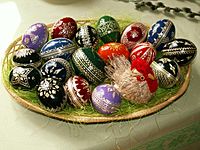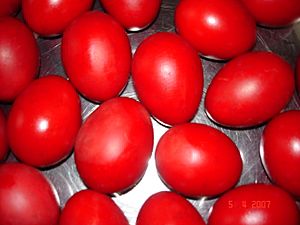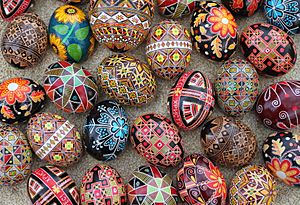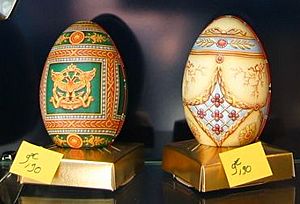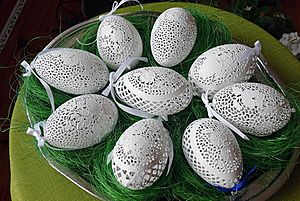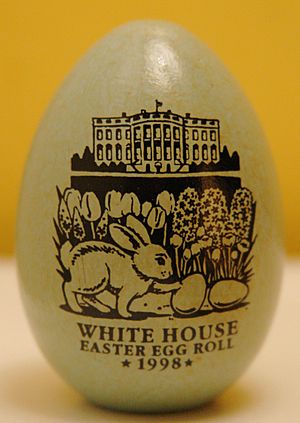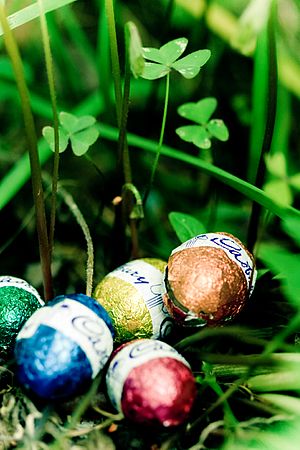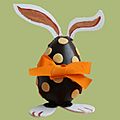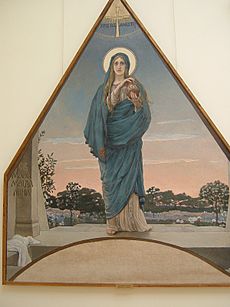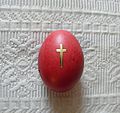Easter egg facts for kids
An Easter egg is an egg, eaten and used for decoration during the Easter holidays. The egg was a symbol of the earth to celebrate spring. It was used by early Christians as a sign of the resurrection (rising from the dead) of Jesus.
Contents
History
Although there have been claims that Easter eggs came from the pagan symbols, there is no solid evidence for this. At the Passover, a hard-boiled egg dipped in salt water is a symbol of both new life and the Passover sacrifice offered at the Temple in Jerusalem. In Christian times, the egg was a symbol of new life just as a chick might hatch from the egg. The Easter egg tradition may have celebrated the end of the privations of Lent. In the Medieval Europe, people were not allowed to eat eggs on fast days. It was traditional to use up all of the eggs that they had before Lent began, and this also made the tradition of Pancake Day. Eggs were viewed as symbols of new life and fertility through the ages. It is believed that for this reason many ancient cultures, including the Ancient Egyptians, Persians, and Romans, used eggs during their spring festivals. In Eastern Christianity, both meat and dairy are still not allowed to be eaten during the fast, and eggs are seen as "dairy" too.
It was during Easter that everybody was trying to get rid of the eggs before the fast. Eggs were given as gifts for children and servants, and used for decoration. And this is probably the reason why eggs came to be associated with Easter.
Decoration and symbolism
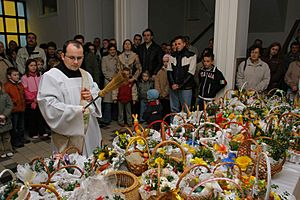
Lenten tradition
The Easter egg tradition may also have merged into the celebration of the end of the privations of Lent in the West. Historically, it was traditional to use up all of the household's eggs before Lent began. Eggs were originally forbidden during Lent as well as on other traditional fast days in Western Christianity (this tradition still continues among the Eastern Christian Churches). Likewise, in Eastern Christianity, meat, eggs, and dairy are all prohibited during the Lenten fast.
This established the tradition of Pancake Day being celebrated on Shrove Tuesday. This day, the Tuesday before Ash Wednesday when Lent begins, is also known as Mardi Gras, a French phrase which translates as "Fat Tuesday" to mark the last consumption of eggs and dairy before Lent begins.
In the Orthodox Church, Great Lent begins on Clean Monday, rather than Wednesday, so the household's dairy products would be used up in the preceding week, called Cheesefare Week.
During Lent, since chickens would not stop producing eggs during this time, a larger than usual store might be available at the end of the fast. This surplus, if any, had to be eaten quickly to prevent spoiling. Then, with the coming of Easter, the eating of eggs resumes. Some families cook a special meatloaf with eggs in it to be eaten with the Easter dinner.
One would have been forced to hard boil the eggs that the chickens produced so as not to waste food, and for this reason the Spanish dish hornazo (traditionally eaten on and around Easter) contains hard-boiled eggs as a primary ingredient. In Hungary, eggs are used sliced in potato casseroles around the Easter period.
Some Christians symbolically link the cracking open of Easter eggs with the empty tomb of Jesus.
In the Orthodox churches, Easter eggs are blessed by the priest at the end of the Paschal Vigil (which is equivalent to Holy Saturday), and distributed to the faithful. The egg is seen by followers of Christianity as a symbol of resurrection: while being dormant it contains a new life sealed within it.
Similarly, in the Roman Catholic Church in Poland, the so-called święconka, i.e. blessing of decorative baskets with a sampling of Easter eggs and other symbolic foods, is one of the most enduring and beloved Polish traditions on Holy Saturday.
During Paschaltide, in some traditions the Pascal greeting with the Easter egg is even extended to the deceased. On either the second Monday or Tuesday of Pascha, after a memorial service people bring blessed eggs to the cemetery and bring the joyous paschal greeting, "Christ has risen", to their beloved departed (see Radonitza).
In Greece, women traditionally dye the eggs with onion skins and vinegar on Thursday (also the day of Communion). These ceremonial eggs are known as kokkina avga. They also bake tsoureki for the Easter Sunday feast. Red Easter eggs are sometimes served along the centerline of tsoureki (braided loaf of bread).
In Egypt, it's a tradition to decorate boiled eggs during Sham el-Nessim holiday, which falls every year after the Eastern Christian Easter.
Colouring
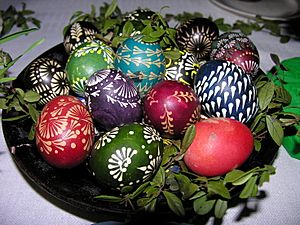
The dying of Easter eggs in different colours is commonplace, with colour being achieved through boiling the egg in natural substances (such as, onion peel (brown colour), oak or alder bark or walnut nutshell (black), beet juice (pink) etc.), or using artificial colourings.
A greater variety of colour was often provided by tying on the onion skin with different coloured woollen yarn. In the North of England these are called pace-eggs or paste-eggs, from a dialectal form of Middle English pasche. They were usually eaten after an egg-jarping (egg tapping) competition.
In the Orthodox and Eastern Catholic Churches, Easter eggs are dyed red to represent the blood of Christ, with further symbolism being found in the hard shell of the egg symbolizing the sealed Tomb of Christ — the cracking of which symbolized his resurrection from the dead.
Patterning
When boiling them with onion skins leaves can be attached prior to dying to create leaf patterns. The leaves are attached to the eggs before they are dyed with a transparent cloth to wrap the eggs with like inexpensive muslin or nylon stockings, leaving patterns once the leaves are removed after the dyeing process. These eggs are part of Easter custom in many areas and often accompany other traditional Easter foods. Passover haminados are prepared with similar methods.
Pysanky are Ukrainian Easter eggs, decorated using a wax-resist (batik) method. The word comes from the verb pysaty, "to write", as the designs are not painted on, but written with beeswax.
Decorating eggs for Easter using wax resistant batik is a popular method in some other eastern European countries.
Use of Easter eggs in decorations
In some Mediterranean countries, especially in Lebanon, chicken eggs are boiled and decorated by dye and/or painting and used as decoration around the house. Then, on Easter Day, young kids would duel with them saying 'Christ is resurrected, Indeed, He is', breaking and eating them. This also happens in Bulgaria, Cyprus, Greece, Macedonia, Romania, Russia, Serbia and Ukraine. In Easter Sunday friends and family hit each other's egg with their own. The one whose egg does not break is believed to be in for good luck in the future.
In Germany, eggs decorate trees and bushes as Easter egg trees, and in several areas public wells as Osterbrunnen.
There used to be a custom in Ukraine, during Easter celebrations to have krashanky on a table in a bowl with wheatgrass. The number of the krashanky equalled the number of departed family members.
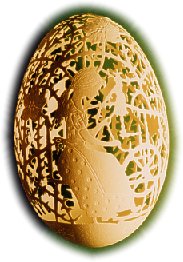
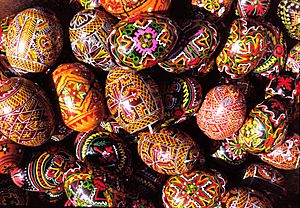
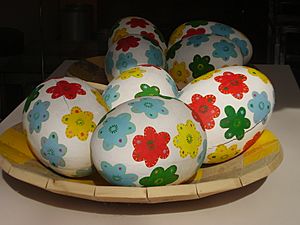
Easter egg games
Egg hunts
An egg hunt is a game during which decorated eggs, real hard-boiled ones or artificial ones filled with, or made of chocolate candies, of various sizes, are hidden for children to find, both indoors and outdoors. When the hunt is over, prizes may be given for the largest number of eggs collected, or for the largest or the smallest egg.
The central European Slavic nations (Czechs and Slovaks etc.) have a tradition of gathering eggs by gaining them from the females in return of whipping them with a pony-tail shaped whip made out of fresh willow branches and splashing them with water, by the Ruthenians called polivanja, which is supposed to give them health and beauty.
Cascarones, a Latin American tradition now shared by many US States with high Hispanic demographics, are an emptied and dried chicken egg stuffed with confetti and sealed with a piece of tissue paper. The eggs are hidden in a similar tradition to the American Easter egg hunt and when found the children (and adults) break them over each other's heads.
In order to enable children to take part in egg hunts despite visual impairment, eggs have been created that emit various clicks, beeps, noises, or music so that visually impaired children can easily hunt for Easter eggs.
Egg rolling
Egg rolling is also a traditional Easter egg game played with eggs at Easter. In the United Kingdom, Germany, and other countries children traditionally rolled eggs down hillsides at Easter. This tradition was taken to the New World by European settlers, and continues to this day each Easter with an Easter egg roll on the White House lawn. Different nations have different versions of the game.
Egg tapping
In the North of England, during Eastertide, a traditional game is played where hard boiled pace eggs are distributed and each player hits the other player's egg with their own. This is known as "egg tapping", "egg dumping", or "egg jarping". The winner is the holder of the last intact egg. The annual egg jarping world championship is held every year over Easter in Peterlee Cricket Club.
It is also practiced in Italy (where is called scuccetta), Bulgaria, Hungary, Croatia, Latvia, Lithuania, Lebanon, Macedonia, Romania, Serbia, Ukraine, Russia, and other countries. In parts of Austria, Bavaria and German-speaking Switzerland it is called Ostereiertitschen or Eierpecken. In parts of Europe it is also called epper, presumably from the German name Opfer, meaning "offering" and in Greece it is known as tsougrisma. In South Louisiana, this practice is called pocking eggs and is slightly different. The Louisiana Creoles hold that the winner eats the eggs of the losers in each round.
In the Greek Orthodox tradition, red eggs are also cracked together when people exchange Easter greetings.
Egg dance
Egg dance is a traditional Easter game in which eggs are laid on the ground or floor and the goal is to dance among them without damaging any eggs which originated in Germany. In the UK the dance is called the hop-egg.
Pace egg plays
The Pace Egg plays are traditional village plays, with a rebirth theme. The drama takes the form of a combat between the hero and villain, in which the hero is killed and brought back to life. The plays take place in England during Easter.
Variants
Chocolate eggs
In 1873 J.S. Fry & Sons of England introduced the first chocolate Easter egg in Britain.
In Western cultures, the giving of chocolate eggs is now commonplace, with 80 million Easter eggs sold in the UK alone.
-
Gladys as a Chocolate Easter Bunny with Easter eggs
Marzipan eggs
In the Indian state of Goa, the Goan Catholic dish Marzipan is used to make easter eggs. In the Philippines, mazapán de pili (Spanish for "pili marzipan") is made from pili nuts.
Artificial eggs
The jewelled Easter eggs made by the Fabergé firm for the two last Russian Tsars are regarded as masterpieces of decorative arts. Most of these creations themselves contained hidden surprises such as clock-work birds, or miniature ships.
In Bulgaria, Poland, Romania, Russia, Ukraine, and other Central European countries' folk traditions, and making artificial eggs out of porcelain for ladies is common.
Easter eggs are frequently depicted in sculpture, including a 27-foot (9 m) sculpture of a pysanka standing in Vegreville, Alberta.
-
Giant easter egg, Bariloche, Argentina
-
Giant pysanka from Vegreville, Alberta, Canada
Legends
Christian traditions
While the origin of Easter eggs can be explained in the symbolic terms described above, among followers of Eastern Christianity the legend says that Mary Magdalene was bringing cooked eggs to share with the other women at the tomb of Jesus, and the eggs in her basket miraculously turned bright red when she saw the risen Christ.
A different, but not necessarily conflicting legend concerns Mary Magdalene's efforts to spread the Gospel. According to this tradition, after the Ascension of Jesus, Mary went to the Emperor of Rome and greeted him with "Christ has risen," whereupon he pointed to an egg on his table and stated, "Christ has no more risen than that egg is red."
After making this statement it is said the egg immediately turned blood red. Red Easter eggs', known as kokkina avga(κόκκινα αυγά) in Greece and krashanki in Ukraine, are an Easter tradition and a distinct type of Easter egg prepared by various Orthodox Christian peoples. The red eggs are part of Easter custom in many areas and often accompany other traditional Easter foods. Passover haminados are prepared with similar methods. Dark red eggs are a tradition in Greece and represent the blood of Christ shed on the cross. The practice dates to the early Christian church in Mesopotamia. In Greece, superstitions of the past included the custom of placing the first-dyed red egg at the home's iconostasis (place where icons are displayed) to ward off evil. The heads and backs of small lambs were also marked with the red dye to protect them.
Parallels in other faiths
The egg is widely used as a symbol of the start of new life, just as new life emerges from an egg when the chick hatches out.
Painted eggs are used at the Iranian spring holidays, the Nowruz that marks the first day of spring or Equinox, and the beginning of the year in the Persian calendar. It is celebrated on the day of the astronomical Northward equinox, which usually occurs on March 21 or the previous/following day depending on where it is observed. The painted eggs symbolize fertility and are displayed on the Nowruz table, called Haft-Seen together with various other symbolic objects. There are sometimes one egg for each member of the family. The ancient Zoroastrians painted eggs for Nowruz, their New Year celebration, which falls on the Spring equinox. The tradition continues among Persians of Islamic, Zoroastrian, and other faiths today. The Nowruz tradition has existed for at least 2,500 years. The sculptures on the walls of Persepolis show people carrying eggs for Nowruz to the king.
The Neo-Pagan holiday of Ostara occurs at roughly the same time as Easter. While it is often claimed that the use of painted eggs is an ancient, pre-Christian component of the celebration of Ostara there are no historical accounts that the celebration of Ostara included this practice, apart from the Old High German lullaby which is believed by most to be a modern fabrication. Rather, the use of painted eggs has been adopted under the assumption that it might be a pre-Christian survival.
There are good grounds for the association between hares (later termed Easter bunnies) and eggs, through folklore confusion between hares' forms (where they raise their young) and plovers' nests.
In Judaism, a hard-boiled egg is an element of the Passover Seder (during the same time as Christian Holy Week), representing festival sacrifice. The children's game of hunting for the afikomen (a half-piece of matzo) has similarities to the Easter egg hunt tradition, by which the child who finds the hidden bread will be awarded a prize. In other homes, the children hide the afikoman and a parent must look for it; when the parents give up, the children demand a prize for revealing its location.
Images for kids
-
Red-coloured Easter egg with Christian cross, from the Saint Kosmas Aitolos Greek Orthodox Monastery
-
Eggs at the Iranian Nowruz
-
Easter eggs from Sorbs
-
Easter egg from Poland
-
Kinder Surprise Egg, manufactured by Italian company Ferrero SpA
-
Giant easter egg in Suceava, Romania
See also
 In Spanish: Huevo de Pascua para niños
In Spanish: Huevo de Pascua para niños


